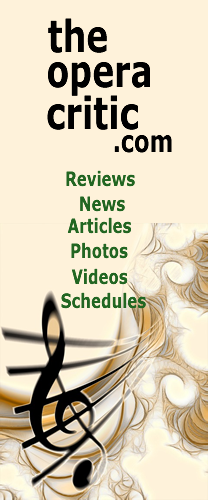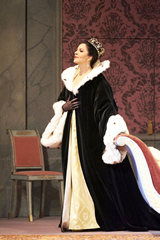| Opera Reviews | 25 April 2024 |
Angela Gheorghiu's Tosca is somewhat modest in scaleby Moore Parker |
|
| Puccini: Tosca Vienna State Opera 8 January 2018 |
|
|
Puccini’s perennial warhorse could well have been re-named Scarpia for this particular occasion, in which Erwin Schrott graced this production for the first time. His Act 1 entrance brought the show to life - intensely focused and proving this tessitura to truly be the ideal playground within which to show his vocal prowess. The tone is rich and full of surprising reserve, allowing Schrott’s natural dramatic instinct plenty of scope for play and the shaping of character. While the interpretation will undoubtedly further grow, the Uruguayan baritone has already secured his position among Vienna’s Scarpia elite - in addition to pointing the way towards other exciting new challenges. Massimo Giordano’s Cavaradossi is an appealing figure - yet almost an enigma in his vocal, and at times stylistic, unpredictability. The mid and upper-mid ranges easily become veiled only to open-up to clarion high notes, and while certain phrases were finely-tuned and sensitively turned, others were roughly-hewn and mismanaged. Both arias were essentially well sung, and Act 2’s outburst, "Vittoria! Vittoria!" was taken with aplomb. Angelotti was solidly sung by Clemens Unterreiner, but here seemed rather stilted dramatically - in contrast to Alexandru Moisiuc’s colourful Sagrestano, and Benedikt Kobel’s intensely-played Spoletta. In comparison with the many predecessors these sets have seen, Angela Gheorghiu’s Tosca leans on the modest side of the scale (both in volume and variety of tonal colour) and at this stage of her career often lends the impression of treading on raw vocal eggs, attacking notes from below, and saving resources where possible, to the point of inaudibility on occasions. Act 1, in particular, was marred by constant late entries in phrases, which subsequently ran into conflict with progress in the pit as well as with her stage partners' lines. Acts 2 and 3 saw some improvement in stage-to-pit discipline, whereby the soprano did nevertheless manage to hold significant lines in her final interaction with Cavaradossi just a touch longer than her tenor colleague. This Tosca is self-consciously “arch” and affected, with "Vissi d’Arte" sung toward Scarpia rather than introspectively. The ensuing murder scene brought a good degree of spontaneity, while dramatically the most convincing moments came in Act 3’s finale as it becomes evident that Tosca’s hopes for freedom are lost and her fate squarely sealed. The issues surrounding the debacle between pit and stage are unlikely to be made public, but the State Opera has just announced the replacement of conductor Jesús López Cobos by Frédéric Chaslin for Friday’s performance - due to reasons of “ill-health”.
|
|
| Text ©
Moore Parker Photo © Wiener Staatsoper / Michael Pöhn |

 The current State Opera revival of Tosca sees two performances - the second of which marks the 600th showing of Margarethe Wallmann’s 1958 enduring production - originally with von Karajan conducting, Renata Tebaldi, Tito Gobbi and Giuseppe Zampieri in the leads. Subsequent casts read like a “Who’s Who” of opera celebrities and include stellar names like Rysanek, Nilsson, Price, Jones, Caballé, and Bumbry in title role, opposite di Stefano, Corelli, Bergonzi, Aragall, Domingo, Botha - and more recently Kaufmann - in the tenor slot, and with London, Hotter, Bastianini, Taddei, Milnes, Raimondi, Lucić, and Terfel among the baritone line-ups.
The current State Opera revival of Tosca sees two performances - the second of which marks the 600th showing of Margarethe Wallmann’s 1958 enduring production - originally with von Karajan conducting, Renata Tebaldi, Tito Gobbi and Giuseppe Zampieri in the leads. Subsequent casts read like a “Who’s Who” of opera celebrities and include stellar names like Rysanek, Nilsson, Price, Jones, Caballé, and Bumbry in title role, opposite di Stefano, Corelli, Bergonzi, Aragall, Domingo, Botha - and more recently Kaufmann - in the tenor slot, and with London, Hotter, Bastianini, Taddei, Milnes, Raimondi, Lucić, and Terfel among the baritone line-ups. 





